Circle Triangle Square Symbol Meanings Explained
Geometric shapes such as circles, triangles, and squares hold deep symbolic meanings across various cultures. The circle represents unity, wholeness, and cyclic rhythms, often symbolizing community and spiritual connection.
Triangles convey strength, balance, and divine harmony, bridging tangible and abstract domains. Squares stand for stability, order, and moral integrity, foundational in mathematics and architecture.
These shapes not only influence art and philosophy but also play pivotal roles in branding and user interface design, guiding and enhancing user experiences. Exploring these symbols further reveals their profound impact on human thought and cultural practices.

Key Takeaways
- Circles symbolize unity, wholeness, and continuity, often conveying inclusivity and balance.
- Triangles represent balance, strength, and harmony, with connotations of divine interconnectedness and dynamic energy.
- Squares denote stability, order, and foundational principles, often emphasizing structure and reliability.
- Circles, triangles, and squares hold distinct cultural meanings, reflecting and shaping collective identities across different societies.
- These geometric shapes enhance branding, user interface design, and architectural aesthetics by providing visual interest, clarity, and usability.
Historical Significance
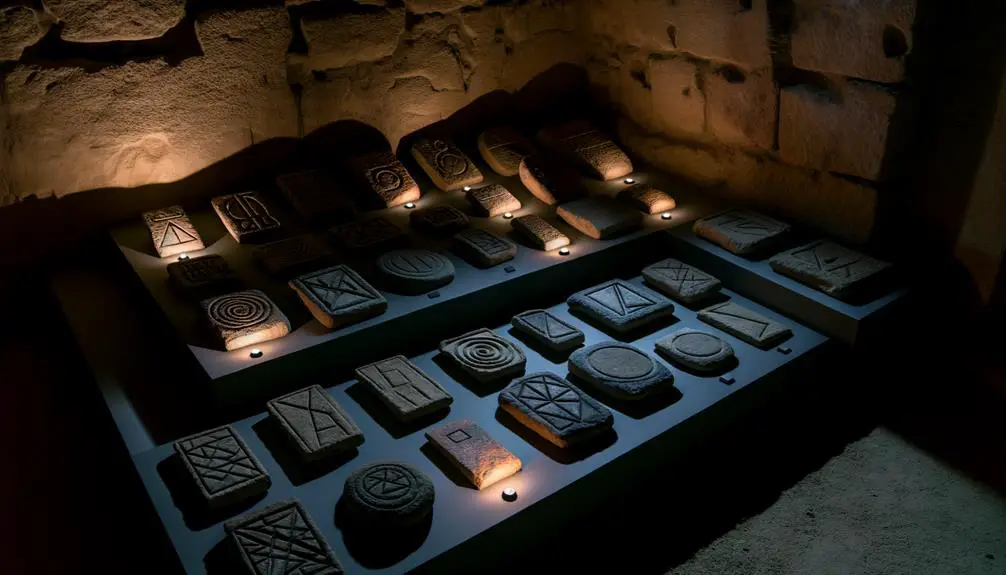
How have geometric symbols such as the circle, triangle, and square influenced human cultures throughout history?
These shapes have served as fundamental elements in art, architecture, and philosophy across diverse civilizations.
The triangle, with its three sides, is often linked to concepts of balance and strength, integral to ancient Egyptian pyramids and Christian symbolism of the Holy Trinity.
The square represents order, stability, and foundation, evident in the grid patterns of urban planning and sacred geometry in many cultures.
These shapes are more than mere figures; they encapsulate profound, often universal, meanings that transcend time and geography.
They are visual languages that have conveyed complex ideas, values, and beliefs, shaping human thought and societal structures for millennia.
Circle Symbolism
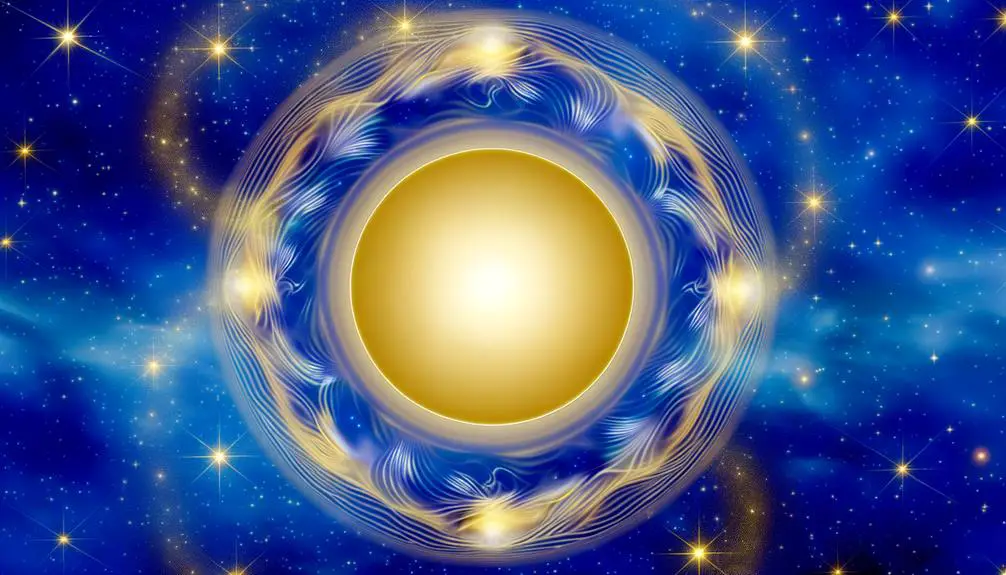
Circle symbolism is rich and multifaceted, embodying concepts such as unity and wholeness, which are essential in understanding its representation of interconnectedness.
Moreover, the circle's continuous form signifies cycles and continuity, reflecting natural rhythms and perpetual renewal.
Additionally, this shape often serves as a powerful emblem of spiritual connection, linking the material and the transcendent in various cultural and religious contexts.
Unity and Wholeness
Embodying the essence of unity and wholeness, the circle has long stood as a powerful and pervasive symbol in various cultures and philosophies. Its continuous, unbroken form represents completeness and infinity, making it a universal emblem of harmony and integration.
The circle's symbolism is multi-faceted and deeply rooted in human consciousness, reflecting a myriad of concepts:
- Inclusivity: Encompassing all within its bounds.
- Equality: Every point equidistant from the center.
- Perfection: Flawless and without beginning or end.
- Community: Bringing individuals together in a shared space.
- Balance: Symmetrical and evenly proportioned.
Understanding these elements provides profound insight into why the circle remains a timeless and revered symbol in art, religion, and science.
Cycles and Continuity
Exploring the circle's symbolic depth, its representation of cycles and continuity is evident through its perpetual, unending shape that seamlessly connects beginnings and ends. This geometric form epitomizes the concept of eternal recurrence, as seen in nature's cycles: the seasons, lunar phases, and life-death-rebirth processes.
The circle's symmetry and closed-loop structure embody the notion of time as cyclical rather than linear, suggesting continuity and renewal. In various cultural contexts, the circle underscores the importance of returning to origins, reflecting on past experiences, and anticipating future ones.
Analytically, it offers a profound metaphor for understanding life's inherent rhythms, emphasizing that every conclusion is but the nascent stage of a new beginning, fostering an appreciation for life's interconnectedness.
Spiritual Connection
In numerous spiritual traditions, the circle serves as a powerful symbol of unity and wholeness, representing the interconnectedness of all existence and the cyclical nature of the universe. Its unbroken form embodies the infinite, suggesting the perpetual flow of time and the eternal cycle of life, death, and rebirth.
The circle's spiritual symbolism can be observed in various practices and beliefs:
- Meditation: Circles are used in mandalas to focus the mind and achieve spiritual balance.
- Rituals: Sacred circles are often formed in ceremonies to create a protected space.
- Mythology: Circular symbols epitomize the cosmos and creation myths.
- Alchemy: The ouroboros, a snake eating its tail, signifies eternal renewal.
- Architecture: Circular designs in sacred structures reflect holistic harmony.
Triangle Interpretations
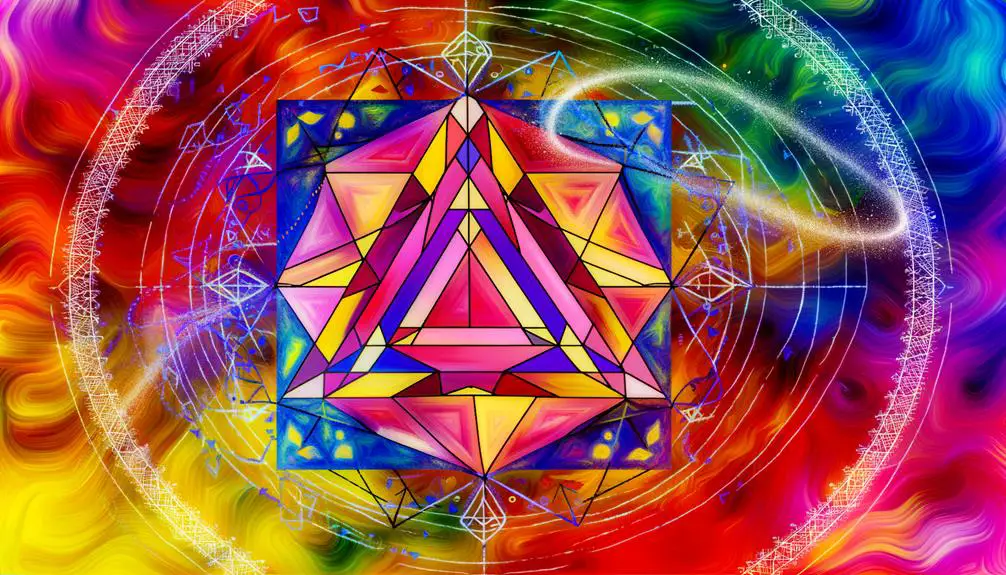
The triangle, with its three distinct sides and angles, often symbolizes concepts such as balance, strength, and harmony across various cultural and philosophical contexts.
In ancient Egypt, the triangle represented a trinity of gods, illustrating the interconnectedness of divine forces.
In alchemy, it signifies the three essential elements: sulfur, mercury, and salt, each pivotal in the transmutation process.
Philosophically, the triangle's structure epitomizes stability, as seen in the architectural use of triangular forms for enduring strength.
The upward-pointing triangle is frequently associated with masculinity and fire, while the downward-pointing one denotes femininity and water.
Through these interpretations, the triangle embodies a fundamental geometric and symbolic essence, bridging the tangible and the abstract in human understanding.
Square Representations
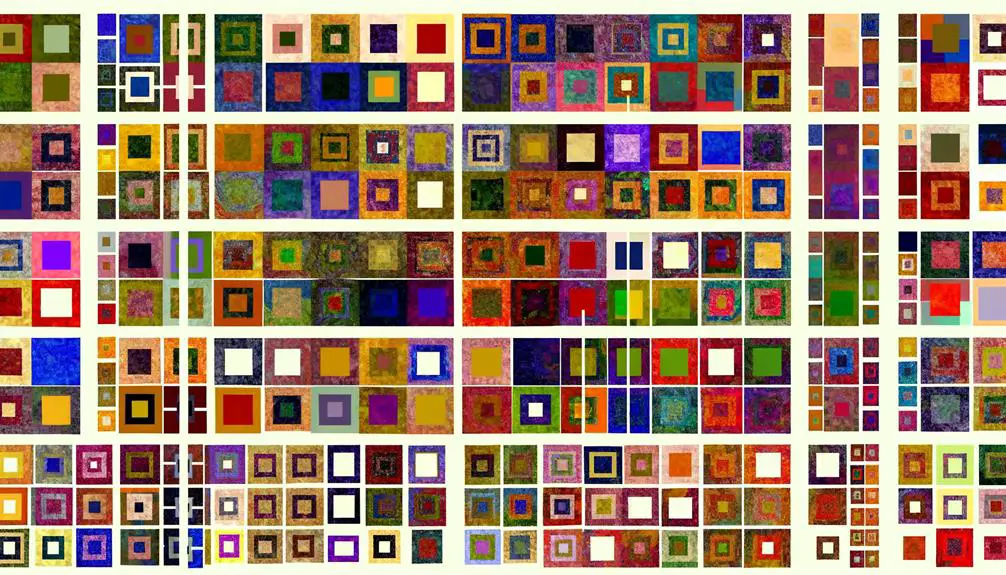
While often perceived as a symbol of stability and order, the square's four equal sides and right angles also represent foundational principles in various cultural, philosophical, and mathematical contexts. This geometric shape is frequently associated with concepts of balance, uniformity, and rationality. It serves as a basis for many architectural designs and is pivotal in the study of geometry.
- Mathematics: Squares are fundamental in Euclidean geometry, forming the basis of the Pythagorean theorem.
- Philosophy: Symbolizes moral integrity and truth in philosophical discourse.
- Architecture: Provides structural stability and aesthetic symmetry.
- Art: Used to convey order and harmony in compositions.
- Psychology: Represents the mind's preference for familiarity and predictability.
The square's multifaceted representations underscore its integral role across disciplines.
Cultural Variations
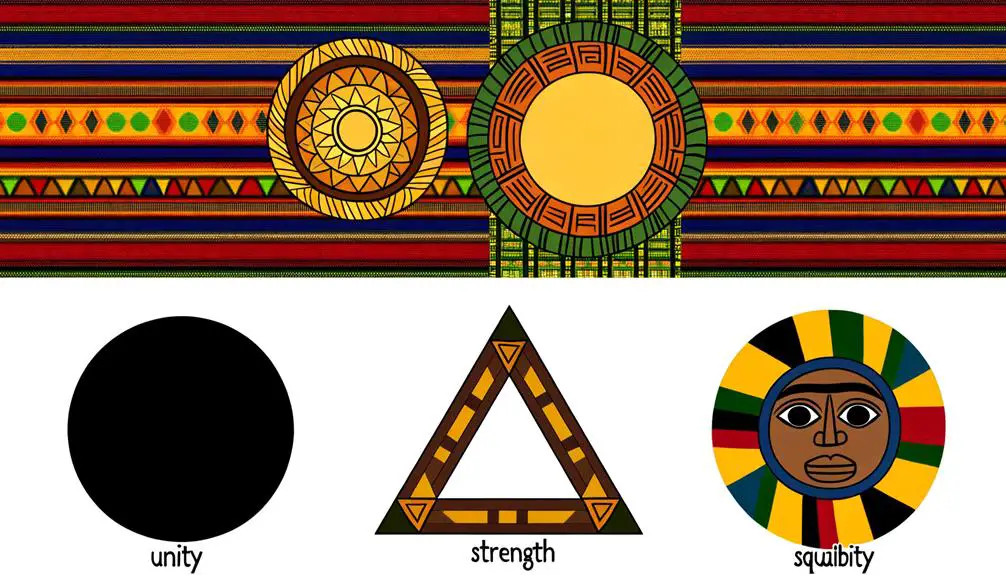
Across various cultures, geometric shapes like circles, triangles, and squares carry distinct symbolic meanings that reflect differing worldviews and traditions.
In Eastern cultures, the circle often epitomizes unity and the cyclical nature of life, symbolizing harmony and eternal return.
Triangles, seen in many indigenous traditions, can signify strength, stability, or the connection between heaven and earth. Conversely, in Western traditions, triangles often represent aspiration and progress.
Squares are commonly associated with order, stability, and rationality in both Eastern and Western contexts, but may also convey materiality and human-made structures.
These culturally specific interpretations highlight how geometric symbols are not merely visual elements but are imbued with profound meanings that shape and reflect collective cultural identities.
Psychological Impact
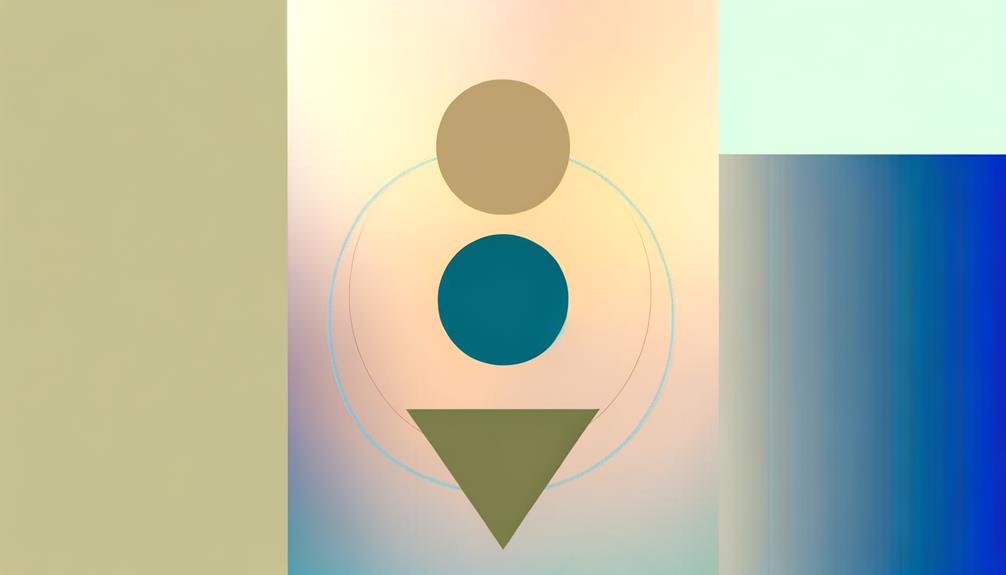
Geometric shapes such as circles, triangles, and squares profoundly influence psychological states by evoking specific emotional and cognitive responses. Circles often symbolize unity and wholeness, eliciting feelings of comfort and inclusivity. Triangles, with their dynamic and pointed form, are associated with action, conflict, and direction, often instilling a sense of urgency or focus. Squares represent stability and order, providing a sense of security and reliability.
These shapes can:
- Influence mood and emotional state.
- Affect perception of space and environment.
- Enhance cognitive processing through visual simplicity.
- Communicate non-verbal messages in design and art.
- Serve as cognitive shortcuts in pattern recognition.
Understanding these impacts allows for more effective use of shapes in various psychological and design contexts.
Modern Applications
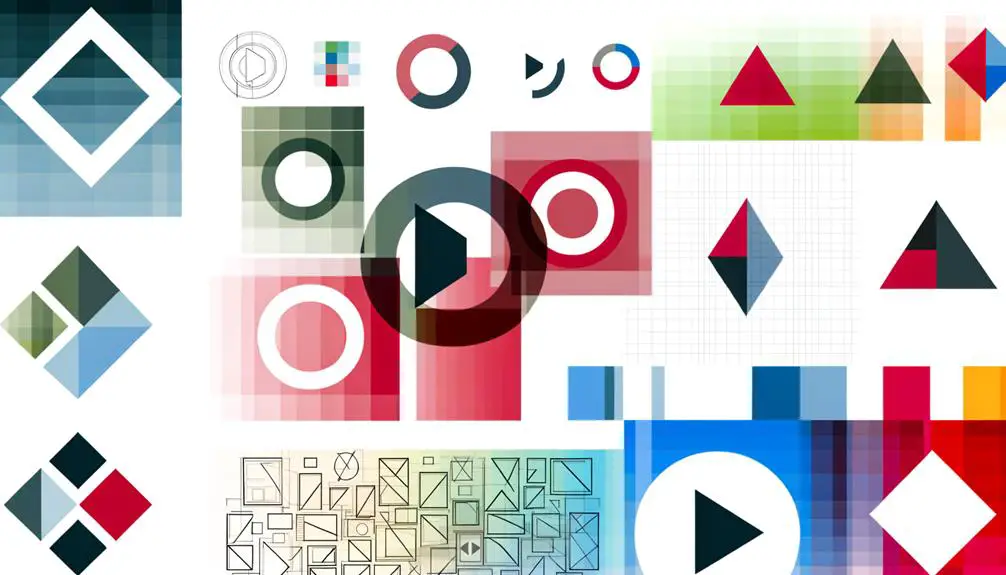
Building on the understanding of the psychological impact of geometric shapes, modern applications leverage these forms in diverse fields such as branding, architecture, and user interface design to strategically evoke desired responses and enhance user experience.
In branding, circles are often employed to convey unity and trust, whereas triangles suggest dynamism and innovation. Architectural designs integrate squares for stability and reliability, while circles create focal points that draw attention.
User interface design utilizes these shapes to guide navigation and improve usability; circles often denote action buttons, triangles indicate progression or direction, and squares represent content areas. This intentional deployment of geometric forms underscores their profound influence on perception and interaction, making them indispensable tools in contemporary design.
Conclusion
In summation, the circle's cyclical continuity, the triangle's transformative principles, and the square's unwavering stability symbolize significant themes throughout history.
Cultural contexts confer varying connotations, while psychological perspectives propose profound impacts on perception.
Modern applications manifest these motifs in myriad mediums, from architecture to art.
An analytical appreciation of these shapes reveals their enduring essence, providing both a reflective reminder of human history and an insightful illustration of contemporary creativity.
These symbols continue to captivate and communicate across cultures and centuries.






